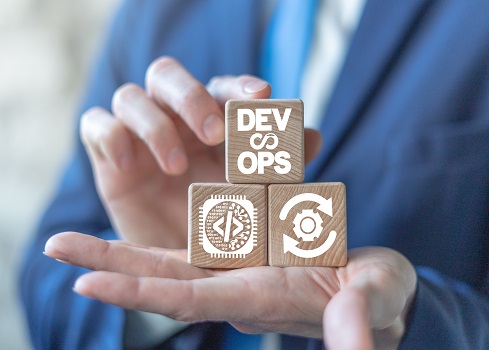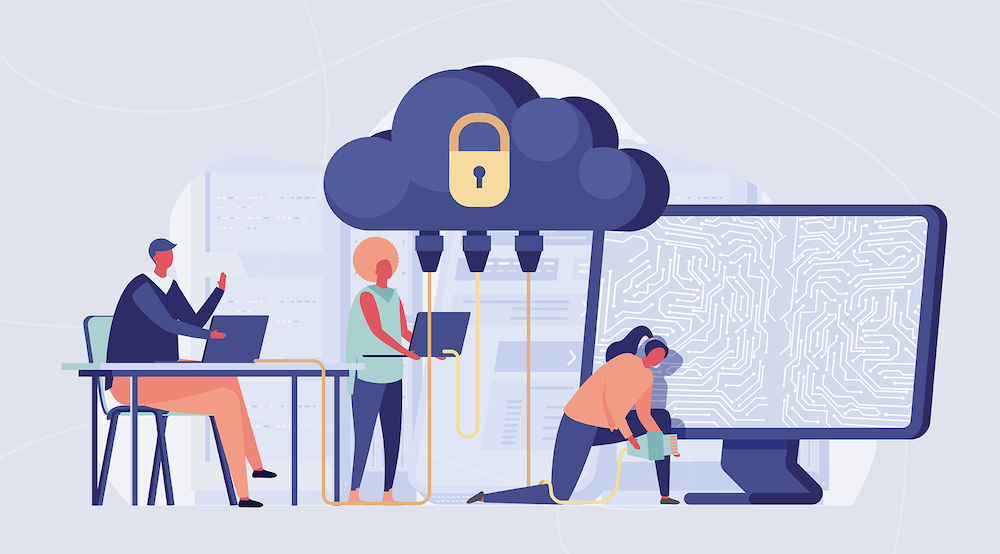Making CI/CD Work for DevOps Teams

The most fundamental people-related issue is having a culture that enables
CI/CD success. "The success of CI/CD [at] HealthJoy depends on cultivating a
culture where CI/CD is not just a collection of tools and technologies for
DevOps engineers but a set of principles and practices that are fully embraced
by everyone in engineering to continually improve delivery throughput and
operational stability," said HealthJoy's Dam. At HealthJoy, the integration of
CI/CD throughout the SDLC requires the rest of engineering to closely
collaborate with DevOps engineers to continually transform the build, testing,
deployment and monitoring activities into a repeatable set of CI/CD process
steps. For example, they've shifted quality controls left and automated the
process using DevOps principles, practices and tools. Component provider
Infragistics changed its hiring approach. Specifically, instead of hiring
experts in one area, the company now looks for people with skill sets that
meld well with the team. "All of a sudden, you've got HR involved and
marketing involved because if we don't include marketing in every aspect of
software delivery, how are they going to know what to market?" said Jason
Beres, SVP of developer tools at Infragistics.
How DNS Attack Dynamics Evolved During the Pandemic

The complexity of the DNS threat landscape has grown in the wake of COVID.
According to Neustar’s “Online Traffic and Cyber Attacks During COVID-19”
report, there was a dramatic escalation of the number of attacks and their
severity across virtually every measurable metric from March to mid-May 2020
– particularly DNS-related attacks. That’s not surprising given the sharp
rise in DNS queries from employees working from home. Whereas business
networks tend to be relatively secure and protected by experienced security
professionals, home routers are set up by un-savvy employees, and are
therefore more vulnerable to DNS exploits. Hackers are taking advantage of
this vulnerability using a technique called DNS hijacking. They gain access
to unsecured home routers and change the devices’ DNS settings. Users are
then redirected to malicious sites and unwittingly give away sensitive
information like credentials, or permit attackers to remotely access their
company’s infrastructure. Neustar has seen a dramatic rise in this type of
attack since the onset of the pandemic. Given that many home networks remain
exposed, this problematic trend is poised to continue well into 2021.
Similar, simpler techniques are also becoming more prevalent.
Top 12 IoT App Trends to Expect in 2021
Automation requirements are everywhere, including industries, and IoT is
well catering to all of them. IoT in industries has been mainly collecting
and analyzing data and work routines for requirements of various devices and
systems, and automating their working. Initially, the role of this
technology was limited to increasing overall industry work efficiency and
operation management with rationalization, automation, and applicable system
maintenance in the manufacturing sectors, mainly within a smart factory
environment. Coming forward, IoT is touted to cross $123 billion in terms of
its industrial vertical only. The technology is set to help industries
within the scope of optimization in their work procedures, intelligent
manufacturing and smart industry, asset performance management, industrial
control, moving towards an on-demand service model, amongst others, even for
cross-industry scenarios in the coming times. It is also set to revamp the
ways of providing services to customers and creating newer revenue models.
It has been actively promoting and helping in enhancing aspects of
industrial digital transformation.
‘The dawn of ‘Fintech 3.0’? ‘

“What we’re seeing is ecommerce moving up and down the value chain,” says
Brear. “I don’t really know which one of the three credit cards I have is
linked to Amazon. But I know, when I press that Amazon button, all of the
fulfilment is done really well. Amazon is moving down that stack into the
financial services space, and giving me three-to-four per cent cashback.
Why would I not do that? “Universal banking as a principle was predicated
on cross- and upselling, where banks were relying on the primacy of their
customer relationship, and selling them 2.3 or 2.4 products, on average,
to make the system work, from a profitability perspective. But, we’re now
seeing that customer ‘ownership’ being unbundled and shared between other
providers, whether Amazon or players like Snoop. They’re provoking
customers into moving, and making it really easy for them to do so.
“That’s the really scary thing. We’ve seen this play out in other
industries – mobile network operators are a great example, because the
consumer doesn’t care what that logo in the corner of the iPhone is now,
they just care that it’s an iPhone. The networks have commoditised
themselves into providing them with data and coverage, which every one of
them does, so it doesn’t really matter [who they go with].
Why you should make cyber risk a business gain, not a loss

In a progressive approach to risk, compliance specialists come together
with IT security and operations to improve posture and compliance across
the organization. In theory, that means gathering and analyzing data on
the regulatory environment, security and privacy, and configuration
management at one time. Only through that deep level of operational
alignment can true technology risk management take place. To do that
effectively, we have to start by thinking of risk as something to gain,
not to lose. In this view, risk becomes a window through which
organizations can assess their health as it relates to operations,
security and regulatory status—a view of the organization over time.
... Many IT teams start their risk assessments by making decisions
based on data from multiple products and discrete tasks. Unfortunately,
this can result in a time-consuming process of reconciling these systems.
... Once data is gathered, it’s analyzed and categorized into various risk
categories. Ideally, this is done continuously, not as a once-a-year
effort. Infrequent assessments will fail to provide a clear and current
picture of the organization’s risk posture. ... Once analysis is signed
off, organizations should be well positioned to recommend or perform
remediation actions to mitigate their risks.
What is a DataOps Engineer?

DataOps engineers’ holistic approach to the data development environment
separates them from other technical team members. At CHOP, data engineers
mostly work on ETL tasks while analysts serve on subject matter teams
within the hospital. Mirizo, on the other hand, works on building
infrastructure for data development. Some of his major projects have
included building a metric platform to standardize calculations, creating
an adaptor that allows data engineers to layer tests on top of their
pipelines, and crafting a GitHub-integrated metadata catalogue to track
document sources. On a day-to-day basis, he provides data engineers with
guidance and design support around workflows and pipelines, conducts code
reviews through GitHub, and helps select the tools the team will use.
Prior to the creation of his position, CHOP’s data team relied on human
beings to manually check Excel spreadsheets to ensure everything looked
okay, engineers emailed proposed changes to code and metadata back and
forth, and the lack of shared definitions meant different pipelines
delivered conflicting data. Now, thanks to Mirizio, much of that process
is automated and tools like Jira, GitHub, and Airflow help the team
maintain continuous, high-quality integration and development.
Unlocking Your DevOps Automation Mindset

Today, enterprises are shifting from waterfall to agile weekly and daily
releases. My belief is that every enterprise needs to adopt a 100% agile
methodology, just like BMW did. Testing and continuous
improvement/continuous development (CI/CD) is key for deploying code in
small chunks and reducing merge issues and refactor efforts. Ultimately,
this increases developer velocity and decreases lead time. The shift from
a partial to a 100% agile model requires more than simply senior
leadership’s resolve. It needs a dedicated pool of certified DevOps
automation consultants, coaches and subject matter experts with experience
in SAFE, LESS, Scrum and Kanban frameworks. Best-in-class enterprises and
OSS toolchains that cater to DevSecOps, service meshes and omnichannel
apps are essential. Simultaneously, agile-based delivery coaching, audits
and continuous support to existing and new delivery teams are a must.
While DORA metrics can serve as a good measure of an enterprise’s DevOps
performance, businesses will need tools to assess DevOps maturity, improve
developer productivity and provide specific recommendations for
improvement. Data will play an important role in decision making and aid
every developer’s performance, more than at any time in the past.
5G, behavioural analytics & cyber security: the biggest tech considerations in 2021

With transmissions speeds reaching ten gigabits per second, and latency
less than 4-5 times that of 4G, 5G will first and foremost revolutionise
IoT and innovative new edge computing services. With this comes the
potential for the wider adoption of driverless cars and the remote control
of complex industrial machinery, to name but two applications. These
examples, however, are just the headlines. Behind the scenes, 5G holds
huge potential for businesses across all sectors looking to ramp up their
digital capabilities. Lower latency and greater bandwidth mean that the
finance and retail industries can perform data analytics in real-time,
paving the way for AI to power bespoke customer service experiences.
Similar applications will be seen in the manufacturing and transportation
sectors, where faster information gathering and enhanced IoT offers both
safer and faster execution of services. An even bigger area of flux is in
the relationship between IT and the workplace. Last year’s shift to remote
working was one of the biggest occupational overhauls in recent memory,
and as it stands, more than four-fifths of global workforce are ruling out
return to office full-time, creating new priorities for CIOs.
Top Considerations When Auditing Cloud Computing Systems

Securing data in your cloud environments comes with unique challenges and
raises a new set of questions. What’s the appropriate governance structure
for an organization’s cloud environment and the data that resides within
them? How should cloud services be configured for security? Who is
responsible for security, the cloud service provider or the user of that
cloud service? Cloud compliance is becoming front of mind for
organizations of all sizes. Smaller companies with limited staff and
resources tend to rely more on cloud vendors to run their businesses and
to address security risks (we’ll get into why this is a bad idea later in
this article). Often roles will overlap with team members wearing many
hats in smaller operations. Larger enterprises frequently keep more
security and compliance duties in-house, using vast resources to create
individual teams for threat hunting, risk management, and
compliance/governance programs. Regardless of size, the challenge of
balancing security and business objectives looms large for all companies.
Security must be built around the business, and Jacques accurately
describes the nature of the relationship: “Security is always a support
function around your business.”
Every CIO now needs this one secret 'superpower'

"Emotional intelligence is something we define as self-awareness,
self-management and relationship management," Rob O'Donohue, senior
director analyst at Gartner, who worked on the report, told ZDNet. "With
emotional dexterity, it's the next level. You have the ability to adapt
and adjust to challenges from a soft-skills, emotional
perspective." Historically, said O'Donohue, CIO roles have tended to
focus on technical skills rather than emotional ones. But as the COVID-19
pandemic swept through the world, forcing entire organizations to switch
to remote working overnight, IT teams were in the spotlight as they worked
relentlessly to keep businesses afloat. "This put CIOs in a position where
they needed to keep a hands-on, door-open policy, and show themselves as a
leader that is willing to listen," said O'Donohue. This is where emotional
skills came in handy – not only to support employees, but first and
foremost to better manage the crisis from a personal point of view.
O'Donohue's research, which surveyed CIOs working directly throughout the
crisis, showed that those who self-scored above average on performance
metrics over the past year were also more likely to cite daily commitments
to self-improvement and self-control practices that helped them weather
the crisis.
Quote for the day:
"Your first and foremost job as a leader is to take charge of your own energy and then help to orchestrate the energy of those around you." -- Peter F. Drucker
No comments:
Post a Comment